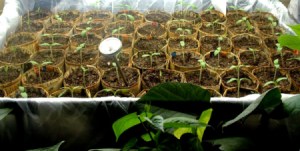Starting seedlings under fluorescent light is one of the best ways for gardeners to get a jump on spring. Because seedlings grown under lights receive the same amount of light day after day, regardless of the weather outside, you won't have to worry about leggy, unhealthy plants during a dark and gloomy spring.
As long as you have a good grow-light system, you can produce your own nursery quality transplants at home for a fraction of the cost.
The best way to provide adequate light for your growing seedling is with cool-white fluorescent tubes. They duplicate the color spectrum of sunlight more closely than any other type of artificial light and are the most efficient to operate.
Don't worry about buying "grow lights" designed especially for starting plants. The inexpensive shop lights commonly available at large home stores work just as well and they are far less expensive.
Shop lights come with a pair of 4 to 6 foot long fluorescent tubes in a fixture that hangs from chains and cost somewhere between $12.00 and $30.00 (with reflectors). The chains attached to the fixture make it easy to raise and lower the height of the lights as your seedlings grow. One shop light should provide enough light for two full-size flats.
Many seedlings prefer extra warmth as they begin to grow. In general, seeds germinate best if the soil temperature is around 75 F. However, some cool-natured plants (like lettuce and snapdragon) prefer cooler germination temperatures around 65 F.
Place containers planted with seeds in a warm place, keeping in mind that the lights from your grow system will generate only a small amount of heat. You can also buy moisture-proof soil-heating cables or pads at garden centers or by mail order. Place them beneath containers to provide steady and even warmth.
After the seeds germinate, normal room temperatures between 65 and 75 F are sufficient to keep them growing vigorously.
The grow-light system you choose will depend on your available space, budget, and the amount of seedlings you plan to grow. A good system allows you to start your seedlings under the same conditions each year, so you can fine-tune your methods and continue to improve your results.
From the single flat of seedlings growing under lights on the kitchen counter, to the complex light system in your basement, whatever you decide, here are a few tips for getting the most out of your lights.

About The Author: Ellen Brown is an environmental writer and photographer and the owner of Sustainable Media, an environmental media company that specializes in helping businesses and organizations promote eco-friendly products and services.
Add your voice! Click below to comment. ThriftyFun is powered by your wisdom!
Thanks, Ellen
I will be going with LED lighting as I find it easier and better in most respects. Getting the best color temperature could be a problem, though. I will post my results with LEDs in the spring.
I realize most people might not have the kitchen counter top space to set up a grow area like mine. I priced all sorts of means to provide the essential bottom heat for seedlings and found that a spare twin electric blanket well protected with plastic was ideal and cost less.
And too, I think it important to keep a check on the soil temperature. With a $3.99 cooking thermometer from the local grocer, I can do just that.
Here is a picture of my tomato seedlings grown under 'daylight' fluorescent lamps. I hope to do even better with LEDs.
Note that even though the electric blanket is completely protected, my trays are also protected with plastic.

Add your voice! Click below to comment. ThriftyFun is powered by your wisdom!